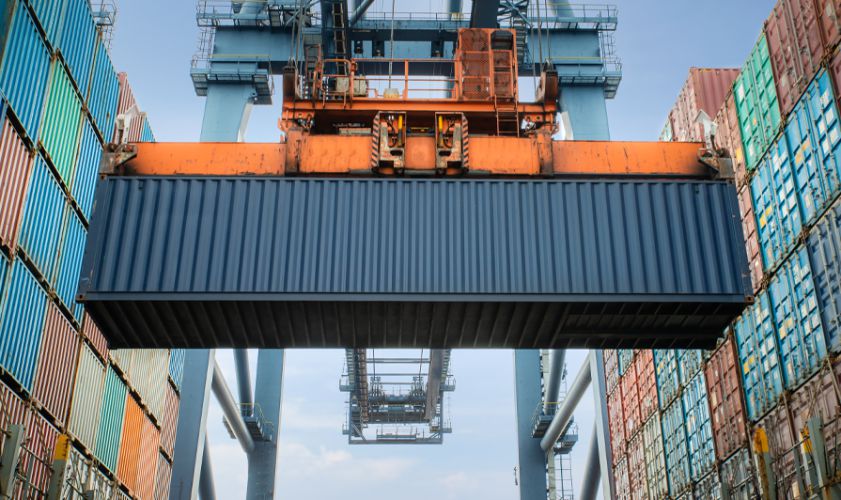- Rent, Lease, or Purchase
- |
October 9, 2021
Shipping Container Delivery: All You Need to Know

Once you've decided to buy a container, you’ll need to arrange shipping container delivery to make sure your units arrive safely. Keep reading to learn more.
Why You Need to Plan Ahead for Shipping Container Delivery
The logistics, delivery, and offloading of a container require expertise and special equipment.
You also have to plan things such as maneuver clearance, overhead obstructions, safe working distance, insurance coverage, equipment selection, and finalize an expert container provider or delivery company. Not working these out early on can lead to additional but avoidable costs.
Work with an end-to-end delivery specialist like Mobile Modular Portable Storage to ensure that your containers are safe, placed properly, and out of the way.
How Can Shipping Containers Be Delivered?
The way shipping containers are delivered depends on the size of the container, distance, and accessibility. Listed below are a few of the most popular methods of delivery:
By Boat

Ships and boats commonly transport shipping container units overseas. Boats are also ideal for areas near busy waterways. Still, it’s important to remember that certain modifications can allow water to enter the container, leading to internal damages. Check with your vendor to make sure the container is watertight. Moving a container in and out of ports will also require additional costs and logistical considerations.
Are shipping containers waterproof? Are they wind and watertight? Read this article to find out.
By Truck
Trucks are one of the most convenient options for delivering and moving containers. Depending upon the size of the container and accessibility of the delivery site, you can select one of the following types of trucks:
Tilt Bed Truck
A tilt bed truck, also known as a tilt tray, is ideal for delivering containers within a 200-mile radius. The driver can tip the truck's bed at a certain angle that allows the cargo to slide off easily. Tilt bed trailers can deliver containers up to 45’ in length.
Note: These containers require 100-feet of straight-line clearance at the delivery site.
Flatbed Truck
If the delivery distance is more than 200 miles, flatbed trucks can be a cost-effective option. Flatbeds have a fixed platform without any surrounding walls. You will need a forklift, crane, or offloading equipment at your location to unload it.
Step-deck trucks are a modified version of flatbeds. They have a fixed, flat platform at a lower height to accommodate taller containers like high cubes.
Learn more about standard shipping containers and their dimensions.
Side-Lifters
Usually, two cranes mounted at the front and rear of side-lifter trucks help move the container. These versatile vehicles can deliver containers ranging from 20’ - 45’ in length. Side lifters have a 42,000-pound load capacity and are pretty handy when it comes to stacking shipping containers.
Crane Truck
You can use crane trucks to deliver smaller storage containers up to 24’ in length. The crane, located between the cab and deck, helps load and offload the container. A certified crane operator must drive the crane truck to ensure safe delivery.
By Train

If a shipping container's point of origin and destination are located near rail lines, trains can be a convenient delivery option. However, delivering a shipping container on trains requires additional logistics, including the journey to and from the railyard and offloading. This process can add to the cost of transportation.
4 Things to Consider Before Your Shipping Container Delivery
Before you schedule your shipping container delivery, there are a few things you need to take into consideration:
Container Permits
Check with your local authorities if you require prior permission to place a container in your location. Contacting a shipping container delivery company can also be helpful, as they are generally familiar with the permission requirements.
Clearance Space
There must be adequate clearance space around the container in order to move it. A 40-feet storage container requires about 100 ft. of straight, 12 ft. of width, and 20 ft. of overhead clearance. The straight distance varies with container length. Make sure there isn’t anything blocking the shipping container. You’ll also need to secure enough space to lift the container and place the offloading equipment.
Site Preparation
The ground must be level, smooth, and firm before you place the container. A concrete pad, paved road, or a sturdy surface can help maintain adequate contact with the ground. Suppliers can provide deliveries on asphalt, gravel, grass, earth, and concrete surfaces.
If the ground is very soft, you can ask the delivery company to support the shipping container with a concrete footing, railroad ties, asphalt, or gravel. Proper support will evenly distribute the container weight and prevent unwanted movement.
Accessibility
Check if the roads near your location are in good condition for truck traffic. Navigating through narrow roads can be an issue in urban areas and may cause difficulties in turning the storage container after loading on flatbeds.
What Should You Keep in Mind During Container Delivery?
The two most important factors that you should note before delivery are:
Delivery time: It is always advisable to check the availability of a container before placing an order. If the container you need is available, you can get it delivered in less than two weeks. Some companies also offer an option to deliver your shipping container faster for an extra fee.
Door Placement: If you want the container doors to face a specific direction, you must note this in advance. There are two ways of loading the container doors:
- Towards the cab of the truck
- Away from the cab
If you place the doors towards the cab, the doors will hit the ground last.
What is the Cost of Delivering Shipping Containers?

Delivery costs include a fixed cost (several hundred dollars) and a per-mile fee. The total price of a container may not include the delivery fee. Delivery prices vary according to:
- The delivery distance
- The size of the storage container
- The type of delivery truck
- Labor and offloading charges
Conclusion
Shipping container delivery requires you to think through every step of the process. Planning your container delivery, using the appropriate mode of transport, and employing specialized equipment can eliminate most hassles.
Outsourcing your container delivery to a specialized company can help you get your shipping container safe and on time for the most reasonable cost. Specialized cranes and equipment also allow you to place the container exactly where you want it.
Mobile Modular Portable Storage is one of the top names in shipping container rentals. Over the last ten years, we have increased our pickups and deliveries by over 14,200%. We have a fleet of delivery vehicles, industry-standard equipment, and highly skilled delivery specialists.
Talk to our dedicated team at 866-459-7600. Our representatives will stay in touch with you from inquiry to installation to ensure the units arrive on time always.
Frequently Asked Questions
How Do Companies Deliver Shipping Containers?
You can get shipping containers delivered by road, rail, or boat. Transporting a shipping container by road requires tilt-bed trucks or flatbeds and loading equipment.
How Much Does It Cost to Move a 40 Ft. Container?
There is no single cost for moving a container. The total delivery cost of a container depends upon the delivery distance, delivery mode, type of truck, and labor and offloading charges. Contact our experts to learn about rental and delivery costs to your location.
How Do You Move a Shipping Container by Yourself?
This video shows one way to move a container on your own. How To Move A Shipping Container By Yourself At Home
If the container is already at your site and you want to adjust the position, you could use a jack to raise the unit a bit, put round pipes under it, and push or pull the unit. Other methods include pulling it with an ATV if you have one. However, we recommend that you work with delivery specialists who can help you do it right the first time.
Related Blogs



Subscribe to Our Blog
Enter your email address to subscribe to the blog and receive the notification of new posts by email.
Thank You for Subscribing to Our Blog!
Stay tuned for upcoming emails with valuable content that we hope will enhance your experience with our brand.
Both Pardot and mg360 form submissions failed.
